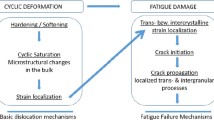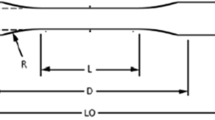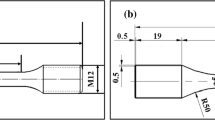Abstract
The growth of persistent slip bands (psb), the initial surface manifestation of metal fatigue, was measured with a photoelectron microscope equipped with a fatigue stage. Once the psb had been identified and located, the specimen was subjected to a final detailed examination by scanning electron microscopy. In 6061-T6 aluminum psb initiated within a grain, usually at the site of an inclusion. The psb appeared as a small extrusion and elongated across the grain by the sequential addition of new extrusions. As the psb elongated, the initial extrusions became more pronounced and eventually microcracks developed. Under constant amplitude loading, the rate of elongation of a psb in polycrystalline material varied inversely as the length, whereas in a large grain specimen the rate remained constant. This difference is attributed to the constraints imposed upon a small grain by the surrounding material. The growth laws can be accounted for in terms of a simple two phase model in which the psb has a much lower yield stress than the matrix of the grain.
Similar content being viewed by others
References
See,e.g., review by C. Laird and D. J. Duquette: inCorrosion Fa- tigue: Chemistry, Mechanics, and Microstructure, O. F. Devereux, A. J. McEvily, and R. W. Staehle, eds., National Association of Corrosion Engineers, Houston, TX, 1971, pp. 88–117.
P. J.E. Forsyth:The Physical Basis of Metal Fatigue, Blackie and Son, Ltd., London, 1969.
J. Lee and C. Laird:Phil. Mag. A, 1983, vol. 47, pp.579–97.
H. Mughrabi:Scripta Metall., 1979, vol. 13, pp. 479–84.
H. Mughrabi, R. Wang, K. Differt, and U. Essmann: inFatigue Mechanisms: Advances in Quantitative Measurement of Physical Damage, J. Lankford, D. L. Davidson, W. L. Morris, and R. P. Wei, eds., American Society for Testing and Materials, Philadelphia, PA, STP 811, 1983, pp. 5–45.
W. J. Baxter: inFundamental Questions and Critical Experiments on Fatigue, J. T. Fong and R. P. Wei, eds., American Society for Testing and Materials, Philadelphia, PA, STP 924, in press.
W. J. Baxter and S.R. Rouze:Metall. Trans. A, 1976, vol. 7A, pp. 647–54.
W. J. Baxter:Treatise on Materials Science and Technology, vol. 19,Experimental Methods, Part B, Academic Press, New York, NY, 1983, pp. 1–66.
See review by P. Lukas and M. Klesnil: inCorrosion Fatigue: Chem- istry, Mechanics, and Microstructure, O. F. Devereux, A. J. McEvily, and R. W. Staehle, eds., National Association of Corrosion Engineers, Houston, TX, 1971, pp. 118–32.
R. Wang, H. Mughrabi, S. McGovern, and M. Rapp:Materials Science and Engineering, 1984, vol. 65, pp. 219–33.
E. E. Laufer and W. N. Roberts:Phil. Mag., 1966, vol. 14, pp. 65–78.
J.R.T. Lloyd, P. Caceres, and B. Ralph:Scripta Metall., 1985, vol.19, pp. 1475–80.
J. Polak,T. Lepisto, and P. Kettunen: Mater.Sci. Eng., 1985, vol. 74, pp. 85–91.
W. Vogel, M. Wilhelm, and V. Gerold:Acta Metall., 1982, vol. 30, pp. 21–30.
C. A. Stubbington:Acta Metall., 1964, vol. 12, pp. 931–39.
S. P. Lynch: inFatigue Mechanisms, J. T. Fong, ed., American Soci- ety for Testing and Materials, Philadelphia, PA, STP 675, 1979, pp. 174–213.
W. Vogel, M. Wilhelm, and V. Gerold:Acta Metall., 1982, vol. 30, pp. 31–35.
J. N. Vincent and L. Remy: Proc. 4th European Conference on Frac- ture, Leoben, Austria, K. L. Maurer and F. E. Matzer, eds., Engineer- ing Materials Advisory Services Ltd., 1982, pp. 353-57.
O. B. Pedersen, K. V. Rasmussen, and A. T. Winter:Acta Metall 1982, vol. 30, pp. 57–62.
H. Mughrabi:Acta Metall., 1983, vol. 31, pp. 1367–79.
J. Gurland:Mater. Sci. Eng., 1979, vol. 40, pp. 59–71.
C.B. Eckstein and J.R.C. Guimaraes:J. Mat. Sci., 1984, vol. 19 pp. 3043–48.
M. Klesnil and P. Lukas:Fatigue of Metallic Materials Elsevier New York, NY, 1980, ch. 3.
N. Thompson, N. Wadsworth, and N. Louat:Phil. Mag., 1956, vol. 1, pp. 113–26.
H. Mughrabi:Mater. Sci. Eng., 1978, vol. 33, pp. 207–23.
P. Neumann: inPhysical Metallurgy, R. W. Cahn and P. Haasen, eds., North Holland, Amsterdam, 1983, p. 1565.
Author information
Authors and Affiliations
Rights and permissions
About this article
Cite this article
Baxter, W.J., McKinney, T.R. Growth of slip bands during fatigue of 6061-T6 aluminum. Metall Trans A 19, 83–91 (1988). https://doi.org/10.1007/BF02669817
Received:
Published:
Issue Date:
DOI: https://doi.org/10.1007/BF02669817




